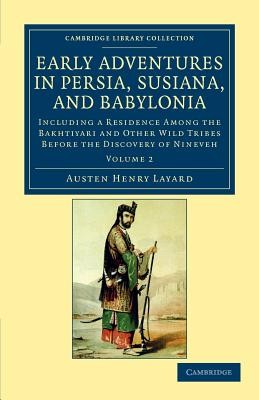
- We will send in 10–14 business days.
- Author: Austen Henry Layard
- Publisher: Cambridge University Press
- ISBN-10: 1108043437
- ISBN-13: 9781108043434
- Format: 14 x 21.6 x 3 cm, minkšti viršeliai
- Language: English
- SAVE -10% with code: EXTRA
Early Adventures in Persia, Susiana, and Babylonia (e-book) (used book) | bookbook.eu
Reviews
Description
Sir Austen Henry Layard (1817-94) was one of the leading British archaeologists of the Victorian period. His excavations at Nimrud and Nineveh led to important discoveries about ancient Mesopotamia, particularly about the Assyrian civilisation, and his popular books such as Nineveh and its Remains (1849) brought archaeology to a wide audience. This book, first published in 1887, tells the story of an 'adventurous journey' Layard had made over forty years earlier, in 1840-2. He learnt Arabic and Persian and travelled widely, even among tribal peoples notorious for their lawlessness. Volume 2 opens with Layard's account of attacks by the Persian military against his hosts, the mountain-dwelling Bakhtiyari tribe. It describes Layard's return journey through Basra and Baghdad to Constantinople, against a backdrop of civil unrest, feuds, kidnapping, theft and robbery, alternating with generous assistance. The book ends with Layard, undeterred by his experiences, planning his next archaeological excavations.
EXTRA 10 % discount with code: EXTRA
The promotion ends in 23d.03:10:38
The discount code is valid when purchasing from 10 €. Discounts do not stack.
- Author: Austen Henry Layard
- Publisher: Cambridge University Press
- ISBN-10: 1108043437
- ISBN-13: 9781108043434
- Format: 14 x 21.6 x 3 cm, minkšti viršeliai
- Language: English English
Sir Austen Henry Layard (1817-94) was one of the leading British archaeologists of the Victorian period. His excavations at Nimrud and Nineveh led to important discoveries about ancient Mesopotamia, particularly about the Assyrian civilisation, and his popular books such as Nineveh and its Remains (1849) brought archaeology to a wide audience. This book, first published in 1887, tells the story of an 'adventurous journey' Layard had made over forty years earlier, in 1840-2. He learnt Arabic and Persian and travelled widely, even among tribal peoples notorious for their lawlessness. Volume 2 opens with Layard's account of attacks by the Persian military against his hosts, the mountain-dwelling Bakhtiyari tribe. It describes Layard's return journey through Basra and Baghdad to Constantinople, against a backdrop of civil unrest, feuds, kidnapping, theft and robbery, alternating with generous assistance. The book ends with Layard, undeterred by his experiences, planning his next archaeological excavations.


Reviews